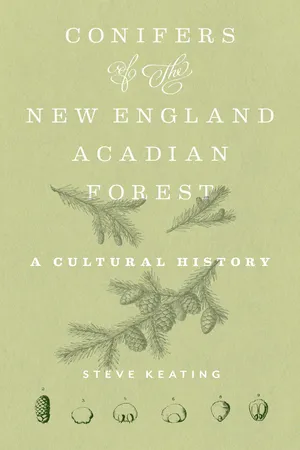
- 288 pages
- English
- ePUB (mobile friendly)
- Available on iOS & Android
About this book
Why did white pine help spark the American Revolution? How did balsam aid the development of germ theory? What does hemlock have to do with making leather? In Conifers of the New England–Acadian Forest, microbiologist Steve Keating explores how conifers influenced the course of human history, writing in a style that is both scientific and accessible.
Keating's study focuses on one of the most forested and wild ecoregions in North America, which extends into New York, New England, and Canada and includes Acadia National Park. Here, spruces, firs, and cedars of the northern boreal forest mix with hemlocks and pines of more temperate climates. This combination helps create the appearance, aroma, and ecology of the region, and the trees' unique botanical traits have been ingeniously utilized by numerous peoples including the Iroquois, French explorers, beer brewers, and shipbuilders. Keating concludes with identification guides for the conifers and where they can be found in Acadia National Park.
Frequently asked questions
- Essential is ideal for learners and professionals who enjoy exploring a wide range of subjects. Access the Essential Library with 800,000+ trusted titles and best-sellers across business, personal growth, and the humanities. Includes unlimited reading time and Standard Read Aloud voice.
- Complete: Perfect for advanced learners and researchers needing full, unrestricted access. Unlock 1.4M+ books across hundreds of subjects, including academic and specialized titles. The Complete Plan also includes advanced features like Premium Read Aloud and Research Assistant.
Please note we cannot support devices running on iOS 13 and Android 7 or earlier. Learn more about using the app.
Information
Table of contents
- Cover
- Half Title Page
- Title Page
- Copyright Page
- Dedication
- Contents
- List of Illustrations
- Acknowledgments
- Introduction: The New England–Acadian Forest Ecoregion
- Chapter 1: A Tree of Life for French Explorers
- Chapter 2: White Pines and the King’s Broad Arrow
- Chapter 3: Boundary Disputes and the Aroostook War
- Chapter 4: White Pines and Red Spruce in the Nineteenth-Century Maine Woods
- Chapter 5: Terpenes and Their Part in Christmas, Spruce Beer, and Tree Defenses
- Chapter 6: Balsam Fir Resins in Medicine, Microscopes, and Germ Theory
- Chapter 7: Pitch Pine Resins in Medicine, Naval Stores, and Colonial Conflicts
- Chapter 8: Hemlock Tannins and Making Leather
- Appendix: Finding and Identifying Conifers at Acadia National Park
- Notes
- Index
- Back Cover